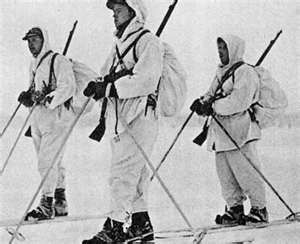 On 30 January 1940, Hitler made a bellicose speech at the Berlin Sportpalast declaring that the first phase of the war was over with the conquest of Poland. At this time, much of the fighting was outside of the ‘official’ Second World War and was taking place on the Soviet-Finnish front. The Soviet-Finnish war began with the Russian invasion of Finland on 30 November 1939. It resulted in the Soviet Union’s expulsion from the League of Nations on 14 December 1939, and continued until a peace treaty was signed on 12 March 1940. Before succumbing to overwhelming odds, the Finns achieved some spectacular successes, including their victory at the Battle of Suomussalmi, during which the Russian 44th Assault Division was annihilated. The week of 29 January–4 February 1940 saw yet another large scale Russian attack, with the Finns yet again holding their position. Towards the end of the week, the British and French were close to making the decision to send an expeditionary force to aid the Finns, albeit at the cost of ignoring Norwegian neutrality.
On 30 January 1940, Hitler made a bellicose speech at the Berlin Sportpalast declaring that the first phase of the war was over with the conquest of Poland. At this time, much of the fighting was outside of the ‘official’ Second World War and was taking place on the Soviet-Finnish front. The Soviet-Finnish war began with the Russian invasion of Finland on 30 November 1939. It resulted in the Soviet Union’s expulsion from the League of Nations on 14 December 1939, and continued until a peace treaty was signed on 12 March 1940. Before succumbing to overwhelming odds, the Finns achieved some spectacular successes, including their victory at the Battle of Suomussalmi, during which the Russian 44th Assault Division was annihilated. The week of 29 January–4 February 1940 saw yet another large scale Russian attack, with the Finns yet again holding their position. Towards the end of the week, the British and French were close to making the decision to send an expeditionary force to aid the Finns, albeit at the cost of ignoring Norwegian neutrality.
It is interesting to speculate what the effect would have been on the early development of the Second World War in western Europe if two of the principal belligerants, Britain and France, had risked opening an entirely new campaign with a different enemy, namely Russia. In the end, Britain and France abandoned their plan. The Soviet-Finnish war cost Finland 25,000 dead, and Russia 200,000.
